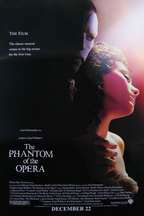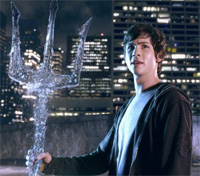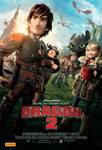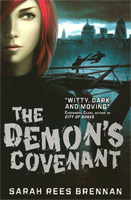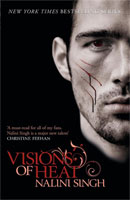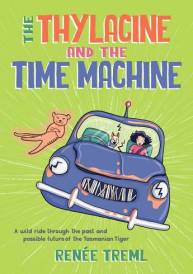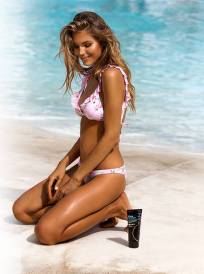Gerard Butler Den of Thieves
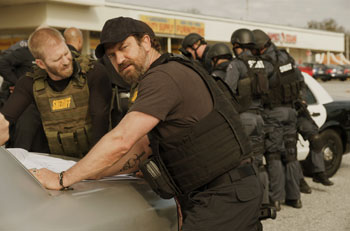
From Screenwriter To First-Time Director
Cast: Gerard Butler, 50 Cent, Pablo Schreiber, Michael Bisping, Evan Jones, Sonya Balmores
Director: Christian Gudegast
Genre: Action, Crime
Synopsis: Den of Thieves is a gritty Los Angeles crime saga which follows the intersecting and often personally connected lives of an elite unit of the L.A. County Sheriff's Dept. and the state's most successful bank robbery crew as the outlaws plan a seemingly impossible heist on the Federal Reserve Bank of downtown Los Angeles.
Set in contemporary Los Angeles, a city with the highest rate of bank robberies in the world, the film takes the traditional 'cops and robbers" formula and gives it a highoctane boost, blurring the lines between good and evil to create a taut action thriller that is equal parts grand heist thriller and psychological crime drama.
The film explores the dynamic between Gerard Butler (Olympus Has Fallen, 300) and Pablo Schreiber (13 Hours: The Secret Soldiers of Benghazi, Orange Is the New Black) as mortal enemies on opposite sides of the law headed toward an explosive showdown.
Butler portrays 'Big" Nick O'Brien, the leader of the Regulators, an elite major crimes squad in the Los Angeles Sheriff's Department hunting the mastermind behind a string of unsolved heists.
Schreiber stars as Ray Merriman, the special forces-trained and recently paroled leader of the Outlaws, a gang of ex-military men whose subject matter expertise and tactical skills have helped them from being captured thus far.
The story of Den of Thieves is reflective of the world we live in. People are complex, the lines between good and bad are not as clearly delineated as we'd like to think, and often, the perceptions of wrong and right are not simply black and white, forcing us to operate in the grey areas as we navigate life's challenges.
Den of Thieves
Release Date: February 1st, 2018
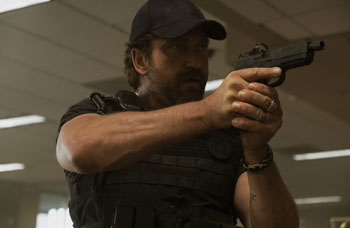 About The Production
About The Production
Introduction To The Story
A gripping thriller that manages to take a familiar concept and make it feel both fresh and timely, Den of Thieves focuses on an elite crew of bank robbers, who plot to pull off the ultimate heist, and the hard scrabble gang unit of the L.A. Sheriff's department working to bring them to justice.
However, in order to pull off the ultimate heist, they'll have to outmaneuver the Regulators – the Major Crimes unit of the Los Angeles Sherrif's Department - who operate in unconventional ways that often blur the thin blue line in order to bring down the most elusive and dangerous criminals. The Regulators are led by alpha dog 'Big Nick" O'Brien (Gerard Butler), a hard drinking career detective seemingly unencumbered by a moral compass. His choices and priorities destroy what remains of his family life. He'll stop at nothing to put an end to Merriman's crime spree, which has been taunting the authorities for years with increasingly ambitious unsolved robberies.
O'Brien is flanked by his protégé, Tony Zapata (Kaiwi Lyman-Mersereau) a charming ladies man, Gus Henderson (Moe Mcrae) a smooth O.G. from South L.A., Murphy 'Murph" Collins (Brian Van Holt) the steely éminence grise, and Benny Magalon, aka 'Borracho" (Maurice Compte) an alcoholic gambler with a talent for turning informers.
After a simple operation to commandeer an armored truck turns into a brutal firefight " resulting in the deaths of armored guards and several police officers " the Outlaws find themselves the primary target of the Regulators. It soon becomes apparent that neither side plays by traditional rules.
Rattled by the robbery gone sideways, Merriman sets his sights on the ultimate heist; infiltrating the Los Angeles branch of the Federal Reserve to and steal $30 million of unfit U.S. currency being taken out of circulation before it can be shredded and destroyed, thereby stealing money that nobody is looking for. Their extensively researched and detailed plan is set into motion and the Outlaws are forced to engage in an increasingly tense game of cat and mouse as the Regulators work to tie Merriman's gang to a string of unsolved heists and anticipate their next move.
There are no heroes or villains in this intricate face off – just highly skilled, equally matched opposites. In a series of escalating confrontations, the city of Los Angeles becomes a giant chessboard, with each side strategically excising the other's pawns, rooks, bishops, knights and queens, to reach a thrilling, and entirely unexpected checkmate.
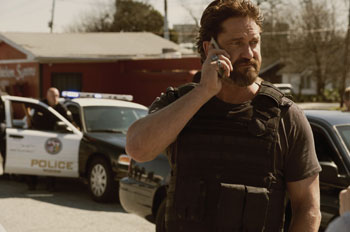 From Screenwriter To First-Time Director: Christian Gudegast Comes Prepared
From Screenwriter To First-Time Director: Christian Gudegast Comes PreparedDen of Thieves is a gritty present-day crime saga with origins dating back to 2002. Screenwriter (and first-time director), Christian Gudegast was reading 'Where the Money Is," a nonfiction book about how Los Angeles became the bank robbery capital of the world, when he saw a photo in the Los Angeles Times; the photo, taken at the Federal Reserve Bank, was of a massive tub of money. The photo and the book sparked an idea, and Christian Gudegast wrote the story that would eventually become the basis for the screenplay.
He was particularly drawn to the complex relationships between professional bank robbers and the detectives who hunt them. 'I was fascinated by the specificity of their worlds," says Christian Gudegast, 'and how these two crews operate. Understanding what they do, and why they do it, became the fuel for the movie."
Christian Gudegast has created a character-driven narrative that turns the traditional heist film on its head. His villains are clean-living athletes and military men who are driven by the challenge of a complex mission more than just the sheer criminality. Conversely, the cops have a penchant for booze, violence, and strip clubs " a far cry from traditional hero archetypes. Christian Gudegast was able to draw on his real-life experiences with people on both sides of the fence to conceive the Outlaws, as well as the Regulators. Despite many development and production challenges, producers Tucker Tooley and Mark Canton have been stalwart advocates for the film. They came on board in 2006 and 2008 respectively. 'I've known Christian Gudegast for nearly 20 years and produced the first movie he wrote," said Tucker Tooley. 'We put it together in many different configurations over the years, and for whatever reason, it always sort of unraveled at the last minute, but we kept at it." Canton agreed: 'You have to be relentless if you believe in the story, and it takes a village to get things done."
Despite intense interest from other producers and directors, Christian Gudegast, who had never directed before, held out to direct his script. Tucker Tooley and Canton were wholly supportive of his decision. Canton notes that despite Christian Gudegast's inexperience, he was up to the task of directing his first feature. 'It was uncanny how prepared he'd become over the course of time, from the look books, from the screen tests, from his entire process of meeting talent along the way," explains Canton. 'His entire process is like a mother of invention story. He was super prepared because he had already played the film over in his head a thousand times. He had storyboarded everything!"
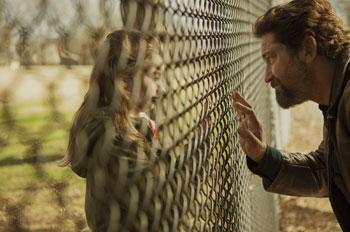 Alpha vs. Alpha: Merriman and 'Big Nick" O'Brien:
Alpha vs. Alpha: Merriman and 'Big Nick" O'Brien:Each group has a true alpha male as its leader; Merriman heads up the Outlaws, while 'Big Nick" O'Brien runs the Regulators. The two are adversaries of equal authority " men on opposite sides of the law, but who share many similarities, as well as a degree of mutual respect. They come from the same environment. They may not know each other, but they understand each other, to a degree. Each is intimidating, but not easily intimidated. Casting was critical to find the right balance and explore the duality between these men.
Both Merriman and O'Brien engage in psychological warfare with each other. It's tough to say who is the cat and who is the mouse. It's the buildup to the inevitable clash; neither man is intimidated. O'Brien and the Regulators casually confront Merriman and his crew at a Japanese restaurant, where 'Big Nick" taunts him, remembering him from their days playing high school football on rival teams. It's O'Brien's way of saying, 'I want you to know I know who you are. I'm going to catch you, and this will come to a head." Merriman responds to O'Brien's provocation in a calm, respectful manner, explaining that he is enjoying a simple family dinner and doesn't want the situation to escalate, as tension crackles in the air.
In one of the film's most intense scenes, Merriman and the Outlaws are at a firing range when O'Brien comes in to clock some time on the same practice range, taunting them. O'Brien walks past them to a vacant lane, takes aim, squeezes off a few rounds, then makes eye contact with Merriman; it's a high-caliber pissing match. As O'Brien resumes his own target practice, Merriman responds by emptying multiple magazines into his target, demonstrating his lethal skills as the range explodes with the sound of his lengthy barrage. He and the Outlaws pack up and leave, exchanging only looks with O'Brien, who satisfies his own curiosity by going over to Merriman's lane and pulls back the paper target, revealing all the center mass shots. Not one word of dialogue is exchanged, yet we know exactly what is being said through their actions.
The two men come face to face again after O'Brien goes home with a beautiful exotic dancer, who turns out to be Merriman's wife, Holly. Merriman arrives home in the morning just as O'Brien exits the bathroom, having spent the night. There is a brief standoff as the two alpha males are literally inches away from each other. Merriman proceeds into the next room and O'Brien leaves. Again, no words are exchanged, yet their silence speaks volumes as they move closer to their inevitable showdown.
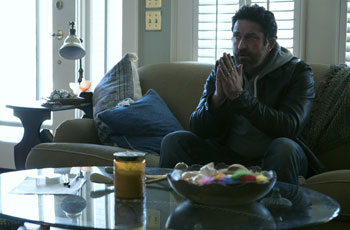 Gerard Butler: Becoming 'Big Nick" O'Brien
Gerard Butler: Becoming 'Big Nick" O'BrienGerard Butler sat on the script for Don of Thieves for several months, despite being urged by his agent to read it. 'I think I was burned out. My agent kept saying, -have you read it?' but I just wasn't in the mood. Then I read it one weekend and it got better and better. I called my agent and said, -Why didn't you tell me to read this, because it's incredible!'"
Gerard Butler expressed an interest in portraying 'Big Nick" O'Brien early on and stayed involved throughout the lengthy development process, eventually bringing his business and producing partner, Alan Siegel along, as well.
Gerard Butler and Gudegast met over numerous raucous dinners to mold 'Big Nick". 'The character's a silverback gorilla who devours everything within reach," laughed the director. 'He's a force. He walks in and he just takes over the environment. Nick is classic. He's funny and he's a badass. He's in major crimes, so he's got to be " he's dealing with the worst of the worst every day, hunting them. We drilled that character all the way down and Gerry was unbelievable."
Gerard Butler's take on 'Big Nick" is bombastic. 'He lives in this world where you have to be willing to go to any length to get ahead and it's incredibly dangerous," said Gerard Butler. 'At first you think he's a punk, but as the character evolves, you understand he's an obsessive and that the pressure is playing on him. He's blown up his life for the job and is emotionally bleeding out because of it."
'What I love about this movie is that it has a taste, an ingredient, of many of my favorite films, like Heist and Heat, with touches of a Dog Day Afternoon and The French Connection," said Gerard Butler. 'But it stands entirely on its own. It may be a complex heist film, but there's a surprising amount of heart and emotion. It has the potential to become one of those unforgettable movies because of the characters we've created."
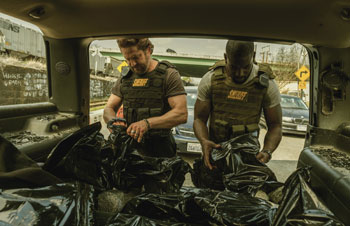 Pablo Schreiber: Making Merriman
Pablo Schreiber: Making MerrimanWhile Gerard Butler had been involved for several years, the physically imposing Pablo Schreiber was on Christian Gudegast's radar from his work in 13 Hours and The Manchurian Candidate.
'Merriman has just gotten out of jail after six years. He's reassembling his guys and he's going after a big fish. It comes to his attention that the Los Angeles branch of the Fed has never been robbed," says Pablo Schreiber of his character. 'He's been preparing for the moment when he would be released. I don't think he ever found anything that has really matched the thrill and excitement (of his military deployment)."
Merriman and his Outlaws share a common military background that serves them well. 'There's a common language we speak. There's no catching up in terms of tactics and team movement. We're well oiled and very efficient," says the actor, who found himself in somewhat familiar territory.
'I had done a movie called 13 Hours with Michael Bay, so I came in with a little bit of knowledge about the weapons. It was great to have a jump start on it; because I had some experience already, I naturally fell into a position of team leader, which was a natural fit for the role," explains Schreiber. 'We worked with a technical advisor who really got us trained up. We spent a lot of time on the range, learning the weapons together really prepared us for when we got to set."
Indeed, that training did pay off. 'There's a great scene at the shooting range where Gerard Butler shows up to intimidate and show his face in front of us. We're all shooting at targets and he starts shooting at a normal clip," says Pablo Schreiber. 'And just to piss him off, I unload four mags straight in about 13 seconds, which is a pretty tough feat. I had to learn to cycle through four mags at really high speeds and really get the technique of being able to do that."
Gerard Butler's O'Brien is tauntingly arrogant and brash, while Pablo Schreiber's performance as Merriman is controlled, subdued even. Christian Gudegast was dazzled by Pablo Schreiber's discipline and intensity. 'Pablo Schreiber's characterization is flawless," he said. 'He pulled off the most chilling behavioral tick by not blinking a lot. His power as an actor is in the in between moments and he never over plays his hand."
Pablo Schreiber was intrigued by Merriman's lack of fear. 'There's a real nihilism to the character," says the actor. 'He's not afraid of death and actually embraces the idea of it. If he's going to go out, he wants to go out on his terms. There's no way he'll ever let Nick cuff him."
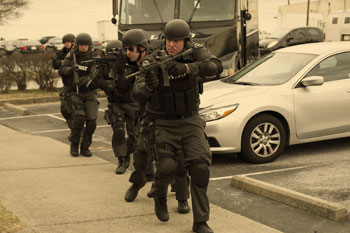 Curtis '50 Cent" Jackson: Right-Hand Man, Family Man
Curtis '50 Cent" Jackson: Right-Hand Man, Family ManAs Merriman's right-hand man, Enson Levoux, Curtis 50 Cent Jackson gives a quietly intense performance, portraying a man who has managed to create a life and a family for himself apart from his criminal life. Levoux and Merriman have a deep bond and a long history; they played high school football together, they joined the Marines and were deployed together, and they came home from their military service together, only to find that civilian life doesn't deliver that adrenaline rush they've become accustomed to. Curtis Jackson first read the script six years ago and reached out to Christian Gudegast. 'He had done a whole look book of the story and it was so well put together with all of the texture and colors that he wanted. His vision for the film has been really well thought out. I wanted to do it then and there," exclaims Jackson. 'I ran into Tucker Tooley at a Golden Globes party and I approached him right away. I put pressure on him you know, -cause I got that rapper thing so I can act like I don't understand. Like -Yo I want to be in this movie' for real.' Like while he had the tuxedos on and with everything he was busy with, he must have thought, -what's the matter with this kid? I like his music but…Okay I understand you want to be in a movie.' And then he changed companies but Tucker knew it was such a good project that he brought it with him. And then it made a full circle. And when I got a chance to talk to him about the film I was like -you don't remember?' and he said -No I remember!' Five years ago, and here I am."
Levoux is a man of few words. He is the Special Forces explosives expert who can communicate more with a menacing look than with a block of dialogue. Curtis Jackson does get to deliver one of the brief humorous moments in the film, as the overprotective father who uses the Outlaws to intimidate the young man who has arrived at his house to escort his teenage daughter to a formal dance.
The scene serves to underscore the theme of family, not just in Enson's wife and five children, but also the chosen family he surrounds himself with " his fellow Outlaws. Because they have each another's back as a family, they can function more effectively as a tactical unit.
Levoux is married with five children. Unlike Merriman, who's never brought anyone into his life to complicate things, he has allowed himself to become vulnerable. Tooley believes Levoux is the heart of the film. 'He's the guy who has the most difficult decisions to make when it comes to the job and his loyalty to Merriman," he said, 'because he has the most to lose."
As the film builds to its explosive climactic showdown, it becomes apparent that what Levoux might lack in conversational skills, he makes up for in strategic thinking"and his ability to wield serious firepower. If you're backed into a corner and have to shoot your way out, '50 Cent's" Enson Levoux is a man you want on your side.
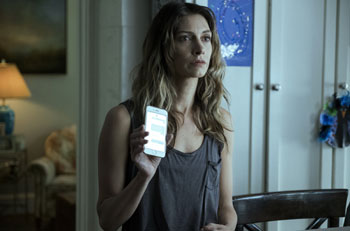 O'Shea Jackson, Jr.: Donnie The Driver
O'Shea Jackson, Jr.: Donnie The DriverFinding the actor to play Donnie, a criminal who is half wide-eyed innocent, and half master game player was a challenge, until Christian Gudegast saw Straight Outa of Compton and O'Shea Jackson, Jr. 'I said -that's him!'" laughed the director. 'He's got this L.A. swag but is also hyper intelligent."
According to Christian Gudegast, Curtis Jackson brings Donnie to life by catching things about the character that aren't on the page, and when up against the towering performances of acting veterans Schreiber and Butler, he more than holds his own. The Outlaws need a driver, and Donnie is the guy they've been looking for. Not only does he know how to fix and rebuild them, he knows how to drive them"fast. In fact, he received the highest speeding ticket in California after they clocked him doing 178 miles per hour, a point of pride for Donnie.
'I'm the new guy in the crew, so I've still got to earn my stripes. They're still putting me through the trials just to get into the fraternity," says Curtis Jackson. 'Big Nick" has been eyeing the Outlaws for a bit, so he knows that he hasn't seen me before. He finds my day job and peeps me out " and sees me as the weak link. Nick decides to be the straw that stirs the drink, and lets my team know he's messed with me."
Donnie demonstrates his loyalty to the Outlaws and plays his part in the plan, taking a job as a deliveryman for a Chinese restaurant, which allows him to infiltrate the Federal Reserve. As the only member of the team to go inside the fortress of the Fed, he becomes the lynchpin to their success.
Rounding out the pack is Evan Jones as Bosco Ostroman, a thief who's as committed to his wellbeing as he is to robbing banks. 'The cool thing about these characters is that they're the family men of the story," said Evan Jones. 'It's interesting to play someone that lives a quiet life by day. These guys work out and are physically fit. You don't see them drinking, smoking or swearing. But at night, they go out and break the law by committing the most dangerous, complicated crimes they can."
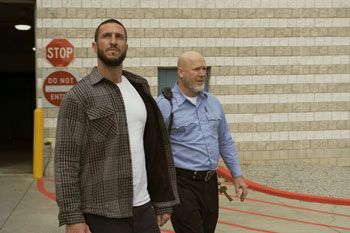 Authenticity Is Key: Boot Camp for Bad Asses
Authenticity Is Key: Boot Camp for Bad AssesTo ensure the characters' weapons mastery looked authentic on the big screen, Christian Gudegast put the actors through rigorous two-week boot camps prior to filming. Each group trained separately, with the Outlaws and the Regulators developing their respective camaraderie, as well as gaining inside knowledge of how their characters would operate in the real world.
Since the action scenes in the film were carefully choreographed, it was essential that the actors had a comprehensive understanding of the weapons and how to physically move with them. 'The advisors that Christian Gudegast brought on took the film to the next level," said Jamie Marshall, executive producer and the film's 2nd unit director. 'They were instrumental in helping to develop the vibe and emotional energy of the actors."
The Outlaws trained with Paul Maurice, who's currently on active duty with the U.S. Armed Forces, and who trains other service members in advanced tactical maneuvers and weaponry. 'He gave the Outlaws tremendous confidence," Christian Gudegast said. 'They trained hard out on the firing range. They drilled in repetition until their movements with the firearms were completely fluid: They could load, unload, change mags – the way they manipulated the firearms was just awesome, and that was Paul's doing."
The Regulators worked with Jay Dobyns, a retired undercover detective from the LAPD gang division. He met Christian Gudegast in 2006 when he was still working as an officer. 'Christian Gudegast is huge on authenticity," he said. 'We often talked about how to successfully translate real life into the script and into his scenes. Everything from how they would carry and hold their weapons, to how they would move with them, to how they conduct themselves inside their vehicles."
Dobyns proved so helpful that Christian Gudegast loosely based 'Big Nick" on him, and used other officers he'd worked with as a template for the rest of the Regulators. Gerard Butler went as far as using Dobyns' speech patterns and many of his mannerisms to give greater depth and authenticity to his performance.
'When boot camp began, I told all the actors that my personal goal is that when people in my profession see the film they'll say, -Those guys were spot on. They were authentic,'" said Dobyns. 'Everything we did was in the service of advancing the characters and getting it right."
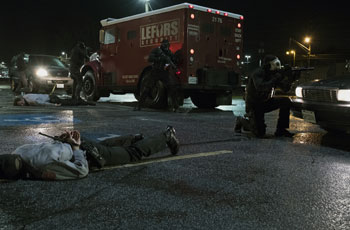 The group practiced techniques and tactics used by plain-clothes detectives, drilling down with great specificity. The two groups have different dynamics. The Regulators were able to create a warm bond that included dinners out, while boot camp for the Outlaws was highly individuated and all business. These disparate approaches ensured the accuracy of their behaviors; the Regulators are street detectives, while the Outlaws function like a military unit, drawing on their individual special forces training for structure.
The group practiced techniques and tactics used by plain-clothes detectives, drilling down with great specificity. The two groups have different dynamics. The Regulators were able to create a warm bond that included dinners out, while boot camp for the Outlaws was highly individuated and all business. These disparate approaches ensured the accuracy of their behaviors; the Regulators are street detectives, while the Outlaws function like a military unit, drawing on their individual special forces training for structure. The two groups used real weapons out in the field to get a feel for the heft and weight of the guns, and then practiced with paintball guns to get used to the mechanics of holding and shooting them while walking, running and jumping.
'The Outlaws are former special forces, so there's more polish to their movements," Dobyns observed. 'They have bigger guns and more ammunition. This is normal because most of the time, the police are outgunned. Part of the story is that the Regulators have to overcome this deficit with their audaciousness and collective experience."
'It was pretty funny," added Pablo Schreiber. 'The Regulators would come to the training ground around the time we were leaving, or vice versa. We kept having these moments where we'd be passing each other and there was animosity and a lot of cold stares – as well as jokes thrown from long distance. It bred this healthy competition, which was good for Gerry and me to have because it bumped things up."
The Look and Feel of Den of Thieves:
Although set in Los Angeles, you won't see the glitzy and glamorous parts of the city. Instead, Los Angeles' southern-most neighborhoods"El Segundo, Torrance, Gardena, Hawthorne, Palos Verdes, Long Beach, and Lakewood"are featured. They comprise a very particular setting that's rarely seen in films. 'The area embodies a blue collar experience that's white, black, Latino and Pacific Islander, and encompasses punk rockers, skaters, surfers and street gangs," said Christian Gudegast, who's from the area and has a passion for its particular flavors. 'So much of who they are is in the clothes they wear and the cars they drive."
Due to fiscal realities and the complexities of shooting in Los Angeles, the film was shot in Atlanta, which created a unique challenge for the filmmakers. Christian Gudegast, a stickler for details and accuracy, had already photographed every Los Angeles location that's mentioned in the script. His look-book included extensive visual references to bars, streets, buildings and even people. No aspect was too small to examine and record.
'When the production team arrived in Atlanta, I was hyper-specific when looking for how we were going to reproduce those elements there," he said. 'It was down to how the murals on walls looked, the color scheme, rims on cars – every detail."
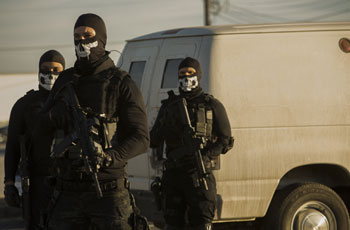 Cinematography
CinematographyEarly on, when Christian Gudegast and cinematographer Terry Stacey (A Dog's Purpose, Elvis and Nixon), talked about the look of the film, Stacey referenced the photographer Andreas Gursky. 'I have Gursky all over my walls," Christian Gudegast enthused, 'I knew immediately that we spoke the same visual language."
Among the challenges Stacey and the locations department faced was finding the look of the very flat industrial areas of Los Angeles in Atlanta. For starters, topography was an issue, as Atlanta is generally hilly and green " a far cry from Los Angeles. Their hard work paid off; the audience will be hard-pressed to notice a 'cheat" for L.A. onscreen. 'We had to work even harder to bring out that look and flavor," said Stacey. 'So as careful as we were in choosing our locations, that same specificity applied to the shots where we sort of went for a hot, Los Angeles weather look; kind of smoggy and golden but not pretty. At night, we play with the natural elements and there's a cooler blue metallic light."
To further achieve the look of the film, Stacey also employed a very fluid, visceral style of shooting – as if the camera were a voyeur. 'When we shot Nick and the Regulators, we used the hand-held a lot. I had him moving in and out of frames, like we're trying to keep up with him. It's rough because his world is fractured." When it came to Merriman and the Outlaws, Stacey was contained and precise. 'We used crane shots and the Steadicam a lot more," he said, 'because Merriman controls the frame when he's in it."
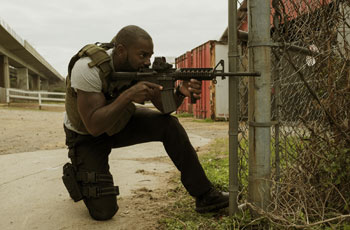 Production Design
Production DesignThe director also worked closely with production designer Kara Lindstrom (Lila & Eve, Crush) and producer Tooley was particularly impressed with her critical eye. 'She would go into a place where it was just four walls and she'd make it look exactly like it did in L.A.," he said. 'For the Federal Bank building, we had a very quick tour and couldn't take any photos. She committed it to memory and pulled it off."
'For me, it was a movie about confinement and freedom. You have lots of small spaces, and lots of large spaces," explains Lindstrom. 'The whole challenge was to create a world where we're always sort of narrowing down and getting trapped, and then opening up again."
The challenge of recreating the Federal Reserve proved especially daunting. 'You have an image of the Reserve being a super fortress, high tech place. It's very secure and mechanized, but it's also the federal government, so it's pretty stripped down and utilitarian," says Lindstrom. 'The goal was to make something utilitarian that was also visually interesting. The security there is based on the workers always being seen " by other workers, they supervisors, or by cameras. It's all about glass, steel, and concrete."
Lindstrom says the donut shop set from the film's opening sequence is a favorite of hers, because the visuals greatly contribute to a sensibility that's exclusive to Los Angeles. 'I gave the donut shop a history. We've got so many different cultures layered on top of one another here," she said. 'I created this backstory: the shop had first been owned by a Mexican American family who had the mural of the donut-themed Lady of Guadalupe painted on the front. Then, I imagined a Korean family had bought it, and they laid their imprint on the space as well. It's people laying all their cultures on top of each other until you get this interesting multi-culti soup " just like the Outlaws and the Regulators."
Costume Design
As part of Christian Gudegast's original look-book, he had taken head to toe, character reference photos of locals. He recorded everything from their shoes, shirts, jeans, and belt buckle preferences, to their watches, hats, jewelry and tattoos. He handed his research over to costume designer Terry Anderson (Jane Got a Gun, A Million Ways to Die in the West), who understood why the director was so concerned with the physical details of this lo-fi, hi-fi world.
'I first read the script and I was thinking, -this writer's unbelievable, the details that he put into it.' Christian knew the neighborhoods these people had come from; he knew everybody and knew how everyone should look," explains Terry Anderson. 'We even pick up on the small clothing differences found in the neighborhoods that each character comes from."
Christian Gudegast said Terry Anderson's grasp of the outlaw Bosco was pivotal. 'She got the entire aesthetic. He's from Huntington Beach, so Terry dressed him in Dickies, old school Converse sneakers, and a wife-beater tank top with a gold chain and another chain hanging from his wallet. It was straight up SoCal, real life, working class gangster."
Terry Anderson also commented that the most interesting challenge of dressing the characters was the lack of differentiation between the Outlaws and the Regulators. 'Both groups were dressed in this sort of South Bay/South L.A., style that also has subtle gang/street elements," she said. 'We pay careful attention to the brands of clothing that are visual cues into how each of these groups live and compartmentalize their lives."
'The biggest challenge to me was trying to live up to Christian Gudegast's script " it's so specifically L.A. I would love to have the movie stand as a snapshot that we haven't really seen in films before."
Ink That Tells A Story
In addition to the specific costume details, Alan Apone (Dunkirk, Suicide Squad), the head of the make-up department, was tasked with creating tattoos to help tell the characters' stories. 'Christian Gudegast knew that the Regulators would all have a bonding tattoo of a skeleton holding a smoking pistol with playing cards," says Apone. 'They're a closely bonded unit, very boisterous, but cohesive. The Outlaws are all very matter of fact. They stay within themselves, but they work well as a unit."
Leading up to filming, each actor had ideas about ink to tell the background story of his character, which made Apone's job even more visible. 'There are a lot of identifiable things. Huntington Beach, South Bay, Ventura"these coastal cities with a sort of gang tattoo that all fit exactly who they are." Apone had to be especially attentive to the meaning of every tattoo – and each character has several. According to the director's meticulous research, every military prison, Southern California street, and Sheriff's department tattoo, sported by the characters, tell specific stories, and each piece even has its own font. Every detail added another layer of complexity to these rich characters.
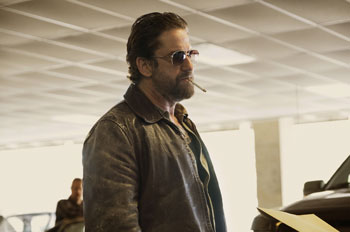 The Right Kind of Gun Fight:
The Right Kind of Gun Fight:In a film where there's extensive gunplay throughout the story, the production armorer is a crucial position. The actors are working with tactical weaponry and shooting tens of thousands of blanks. Safety is paramount and it all has to look legitimate. The filmmakers worked with Janette Latrelle (Battle Los Angeles, G.I. Joe: Retaliation), a weapons expert and one of the rare female armorers in the film industry.
Janette Latrelle, who began collecting firearms when she was 18, trained with the same weapons the actors use, and attended and trained them at their boot camp as well. 'It's safety first. You don't want any injuries or mishaps because we're dealing with something that can potentially hurt or even kill someone," she said. 'It's critical that everyone knows what they're doing. The Outlaws were firing military weapons that fire 30, 30, 30 rounds. When they were out practicing in the field, they had room to spread out – but try doing that when you're filming and have 200 people milling about in close proximity. That's where you have to be really conscientious."
Jamie Marshall was astonished by the weapons technique of the actors, and the overall commitment to a realistic depiction of gun fights. 'I've worked on a lot of John Woo movies," he said 'and one of the things that doesn't ever ring true to me is that the characters never seem to run out of bullets. It was fantastic to watch our actors reload on camera in real time. You're able to stay in the moment. It's messy and exciting, and feels real."
Shot over a period of ten days during the 52-day shoot, the most intense gunplay takes place during the pivotal Alameda Corridor scene. The production took over four city blocks and a third of a mile of highway. The production used 250 cars and destroyed 50 of them. They also unloaded at least 10,000 rounds of ammunition. To intensify the mood of this scene, the director opted out of using music. The audio of rounds firing off and impacting walls, cars and people is the sound that defines the action.
Terry Stacey was continually vexed by the rapidly changing weather. However, he was ultimately successful in recreating that stretch of Alameda, as it would be imagined during the most hellish of gunfights. By using long lenses and wide shots, he was able to focus on individual characters in a sweeping cinematic way and also sustain the illusion that the action was happening in Los Angeles.
Gerard Butler loved the challenge of the scene. 'The thing about the Alameda Corridor is that by the time it happens you're completely emotionally invested in the characters," he said, 'and this event is taking place in the worst possible place at the worst possible time. Everyone is just trapped. Absolutely everything is unleashed during that sequence. It's a huge adrenaline rush."
Den of Thieves
Release Date: February 1st, 2018
Have You Seen This?
MORE


